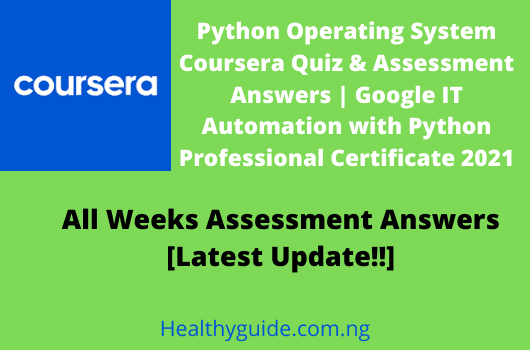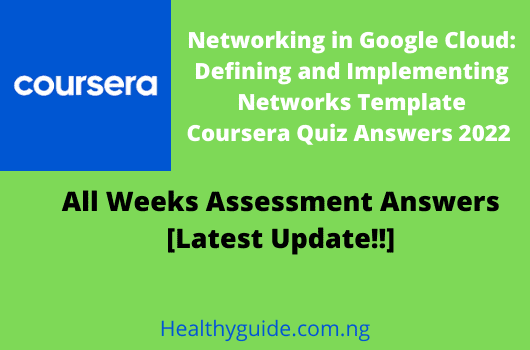Accounting for Business Decision Making: Measurement and Operational Decisions Coursera Quiz Answers 2023 | All Weeks Assessment Answers
Today at healthyguide we provide 100% correct✅ answers of all week, assessment, and final exam answers of Accounting for Business Decision Making: Measurement and Operational Decisions Coursera Quiz Answers from Coursera Free Certification Course.
Apply Here – Accounting for Business Decision Making: Measurement and Operational Decisions
Accounting for Business Decision Making: Measurement and Operational Decisions Quiz Answers
Week 1 Quiz Answers
Quiz 1: Practice Quiz
Q1. Gina, the owner of House Painting International, sends out
an email to the managers and employees in her company. In the email, she makes
reference to the “lifeblood” of the organization. Per the module video, to what
is she referring?
- Owners
- Managers and employees
- Decisions
- Information
Q2. Suppose you are growing vegetables and decide to sell these vegetables at a local
farmers’ market. Which of the following reflects frequent, operational
decisions you are likely to make? (Check all that apply.)
- How to display your vegetables at the market
- Whether to purchase more land
- Whether to water your garden plots
- Whether you will advertise in a local paper
Quiz 2: Practice Quiz
Q1. Which of the following concepts is part of the definition of managerial
accounting? (Check all that apply.)
- Relevant information
- Auditing the accuracy of information
- Ensuring appropriate taxation
- Achieving organizational goals
Q2. Which of the following best reflects the decision-influencing role of managerial
accounting information?
- Align managers’ and employees’ decisions with
what is best for the organization. - Ensure that owners’ and managers’ incentives are sufficiently different.
- Create, organize, and share the right information to allow for the best decision.
- Use cost information to predict decision outcomes.
Quiz 3: Conceptual Quiz
Q1. According to the lecture, what decisions are made within organizations?
- Mundane, everyday decisions
- Long-term, strategy-oriented decisions
- Decisions made by owners of an organization
- All of the above
Q2. Who are decision makers within organizations? (Check all that apply.)
- Owners
- Employees
- Managers
- Consultants
Q3. True or false? Most decisions in organizations are scheduled and occur at regular intervals.
- True
- False
Q4. According to the lecture, what is the “lifeblood” of the organization?
- Owners
- Managers and employees
- Decisions
- Information
Q5. Suppose you are opening a mobile phone and tablet repair kiosk in a mall. Which of the following decisions are you likely to make? (Check all that apply.)
- Whether to expand to other mall locations
- How to price repair services
- Whether to hire employees
- What method of advertising you will use
- How much rent you will pay mall owners
Q6. Suppose you are opening a mobile phone and tablet repair kiosk in a mall. Which of the examples of information might you find useful? (Check all that apply.)
- Competitors’ prices for similar services
- Rent costs
- Location opportunities
- Employee qualifications
- Number of individuals visiting the mall
Q7. Which of the following sub-disciplines relates most to decisions made within the organization?
- Managerial accounting
- Forensic accounting
- Financial accounting
- Auditing and assurance services
Q8. Which of the following concepts are part of the definition of managerial accounting? (Check all that apply.)
- Creating information
- Analyzing information
- Selling information
- Obtaining information
Week 2 Answers:
Quiz 1: Practice Quiz
Q1. True or false? A cost is best defined as the
price paid for a good or service.
- True
- False
Q2. Which of the following best defines the concept of an opportunity cost?
- Value of the best use of a resource
- Value of the next best alternative
- Usage of a resource
- Time-oriented cost
Q3. Leo, an employee at a mobile phone sales and service store,
is preparing a cost report for the current month. In the past, he has focused
on financial costs. However, he has recently broadened his view.
Given his new perspective, which costs would Leo
likely include in his report? (Check all that apply.)
- Wages paid to managers and employees
- Value of the second-choice option in a recent decision
- Projected revenues from Leo’s third-choice in a four-option decision
- Money spent on materials
Quiz 2: Practice Quiz
Q1. Which of following best characterizes different categories of product costs?
- Finished goods and cost of goods sold
- Variable costs and mixed costs
- Direct materials and indirect materials
- Direct materials, direct labor, and overhead
Q2. Which of the following organizations would likely rely on a process costing
system? (Check all that apply.)
- Consulting firm
- Postal service
- Clothing manufacturer
- Custom automobile manufacturer
Q3. True or false? An organization implementing
activity-based costing likely intends to increase the accuracy of cost
information.
- True
- False
Quiz 3: Conceptual Quiz
Q1. Which of the following is the best definition of a cost?
- Usage of a resource
- Something an organization owns or has the right
to use - Price paid for a good or service
- Value of the next best alternative
Q2. True or false? Like cash and materials, time is an example of a resource.
- True
- False
Q3. Which of the following are examples of an organization’s costs? (Check all that apply.)
- Employees’ time spent providing services to customers
- Cash paid for rent for corporate headquarters
- Materials in their raw form waiting to be put into process
- Raw materials put into the production process
- Revenues collected from customers
Q4. True or false? Costs are sometimes difficult to measure accurately.
- True
- False
Q5. True or false? Opportunity costs are often difficult to quantify.
- True
- False
Q6. Jerry, a manager at Wildcat Incorporate, is explaining basic management concepts to new employees. He is speaking about resources and costs. Which of the following statements Jerry makes are accurate? (Check all that apply.)
- “Wildcat incurs costs when its resources are used.”
- “Not all of Wildcat’s costs are financial.”
- “The only costs that matter are those that can be quantified in currency terms.”
- “Wildcat never incurs opportunity costs.”
Q7. Which of the following best defines a cost system?
- Method of organizing cost information to facilitate, but not influence, decisions
- Method of accounting for financial and non-financial costs separately
- Method of determining the best price to pay for goods and services
- Method of organizing cost information to facilitate and/or influence decisions
Q8. What differentiates direct materials and direct labor from overhead?
- Overhead excludes all materials and labor, regardless of traceability to products.
- Direct materials and direct labor are costs that are traceable to products, while overhead costs are not feasibly traced to products.
- Materials and labor are not feasibly traced to a product, while overhead cost are traceable to products.
- Direct materials and direct labor account for more of a product’s costs than overhead.
Q9. Which of the following reflect process costing systems? (Check all that apply.)
- Used in custom-product settings
- Allocates costs to products based on quantity
- Organizes costs by project or engagement
- Used in high-volume settings
Q10. Which of the following reflect job costing systems? (Check all that apply.)
- Organizes costs by project or engagement
- Allocates costs based on quantity
- Allocates costs based on usage of different resources
- Used in high volume settings settings
Q11. Which of the following organizations would likely rely on a job costing system? (Check all that apply.)
- Vegetable farmer
- Custom sailboat manufacturer
- Law firm
- Package delivery service
Q12. True or false? An organization implementing activity-based costing likely intends to increase the accuracy of cost information.
- True
- False
Q13. A consultant who has worked on multiple engagements compares two clients in terms of likelihood that each will implement an activity-based costing system. She identifies Shark Corporation as more likely to use activity-based costing than Duck Company. Which of the following statements support this assessment? (Check all that apply.)
- Shark Corporation’s costs are higher than Duck Company’s costs.
- Shark Corporation’s overhead costs are a larger proportion of its overall costs than Duck Company’s overhead cost proportion.
- Both organizations can feasibly rely on overhead estimates.
- Shark Corporation requires more refined cost information than Duck Company.
Q14. Which of the following reflect disadvantages of activity-based costing? (Check all that apply.)
- Provides less accurate cost information than traditional systems
- Requires more cost system maintenance
- Requires managers to engage in a substantial implementation process
- Managers might use activity-based costing to view more than product costs
Q15. Which of the following best characterizes organizations’ need to organize costs according to behavior?
- Organizations adopt the perspective of external users of financial information.
- Many decisions require making predictions about what costs will be.
- Organizations require more accurate cost information than traditional cost systems allow.
- Organizations need to break-even.
Q16. Gina, a manager at Badger Express, is explaining cost behavior to her employees. Which of the following statements is Gina likely to make?
- “Mixed costs have both variable and fixed components.”
- “Costs that are classified as variable costs do not change over a given ranges of activity.”
- “Total variable costs and total fixed costs are linear, regardless of the range of activity being applied.
- “Costs that are classified as fixed costs do not change over a given range of activity.”
Q17. Gopher Inc. produces televisions. Assuming the activity of interest is production volume, which of the following are variable costs? (Check all that apply.)
- Electricity bills for a production factory
- Manufacturing supervisor salaries
- Wages paid to production line employees
- Rent paid for production equipment
Q18. Sharon owns a restaurant and also caters custom food for special events. Given the various sources and types of costs in her business, which of the following statements represents advice that you would give to Sharon? (Check all that apply.)
- Activity-based costing will simplify the accounting for overhead costs and allow Sharon to rely on estimates.
- Job costing might be useful for the restaurant business.
- Separating costs into materials, labor, and overhead will help predict future costs.
- Process costing might be useful for the restaurant business.
Week 3 Answers:
Quiz 1: Practice Quiz
Q1.Which of the following are true statements about the financial and managerial
approaches to profit? (Check all that
apply.)
- The managerial approach contains the contribution margin measure.
- The financial approach contains the contribution margin measure.
- The financial approach contains the gross margin measure.
- The managerial approach contains the gross margin measure.
Q2. Which of following is true about the contribution margin? (Check all that apply.)
- The contribution margin is used for internal
decision-making. - The contribution margin is always reported on a per-unit basis.
- The contribution margin is always reported in total.
- The total contribution margin varies with number
of units sold.
Q3.Brand Company has the following financial perspective of profitability for the current month:
Gordon, a manager at Brand Company, has decided to adopt a managerial perspective of profitability.
Using the provided information, which of the following statements are true about the managerial perspective? (Check all that apply.)
- Contribution margin will be $19,000.
- Contribution margin will be $22,000.
- Contribution margin will be $23,000.
- Profit will be $10,000.
Quiz 2: Practice Quiz
Q1. Which of the following statements are accurate about cost-volume-profit analysis? (Check all that apply.)
- When the total fixed costs decrease, the break-even point decreases.
- When the sales price increases, the break-even point increases.
- When the variable cost per unit increases, the break-even point decreases.
- When the total fixed costs increase, the break-even point increases.
Q2. Which of the following reflect limitations of cost-volume-profit analysis? (Check all that apply.)
- It separates variable costs and fixed costs.
- It is subject to assumptions.
- It relies on estimates.
- The results of an analysis may not always apply if the business environment changes.
Q3. Janesville Company has the following information related to its manufacturing and selling of computer monitors.
Analysts compute the break-even point using the above information and conclude that production capacity and estimated sales can reach that point.
However, a few days later, the analyst learns that revenues will increase by 20%.
What is the effect of this change on the original break-even point?
- A decrease of 20%
- A decrease of 397 monitors
- A decrease of 662 monitors
- An increase of 662 monitors
Quiz 3: Quantitative Analysis Quiz
Q1. Gas Corporation has the following managerial perspective of profitability for the current month:
Shelly, a manager at Gas Corp., is preparing a profitability report for the lending officer at Gas Corp’s bank.
Using the provided information, which of the following statements are true about the financial perspective? (Check all that apply.)
- Profit will be $3,000
- Total cost of goods sold will be $4,000
- Gross margin will be $15,000
- Gross margin will be $12,000
Q2. Jonas Company has the following information related to its manufacturing and selling of decorative vases.
What are the variable costs and fixed costs that Jonas Company will use to calculate the break-even point?
- $1.25 (Variable) and $400,000 (Fixed)
- $6.75 (Variable) and $750,000 (Fixed)
- $5.50 (Variable) and $750,000 (Fixed)
- $6.75 (Variable) and $1,150,000 (Fixed)
Q3. John Company has the following information related to its manufacturing and selling of desk lamps.
What is John Company’s break-even point for desk lamps?
- 600,000 lamps
- 400,000 lamps
- 300,000 lamps
- 200,000 lamps
Q4. Beloit Corporation has the following information related to its manufacturing and selling of computer back-up hard drives.
Analysts compute the break-even point using the above information, and conclude that production capacity and estimated sales can reach that point.
However, a few days later, the analyst learns that fixed costs will decrease by 5%.
What is the effect of this change on the original break-even point?
- An increase of 155 drives
- A decrease of 155 drives
- An increase of 250 drives
- A decrease of 250 drives
- No change
Q5. James Company has the following information related to its manufacturing and selling of staplers.
Which of the following are true regarding the assumptions of James Company’s cost-volume-profit analysis? (Check all that
apply.)
- If variable costs change, direct labor costs will be half of direct materials costs.
- Demand will be sufficient to warrant an average price of $6 per unit.
- Fixed operating expenses of $5,000 is sufficient to achieve the break-even volume.
- Fixed manufacturing overhead of $20,000 is sufficient to achieve the break-even volume.
Quiz 4: Conceptual Quiz
Q1. True or false? The managerial approach to profit is the approach designed to share information outside of the organization.
- True
- False
Q2. Which of the following are true statements about the financial and managerial approaches to profit? (Check all that apply.)
- Both approaches report the same revenues.
- Costs are reported differently across the two approaches, and therefore, profit is never the same.
- Both approaches report the same profit, but the information that comprises profit is organized differently.
- The managerial approach is less useful.
Q3. Which of following is true about the contribution margin? (Check all that apply.)
- The contribution margin is used for internal decision-making.
- The contribution margin is always reported on a per-unit basis.
- The contribution margin is always reported in total.
- The total contribution margin varies with number of units sold.
Q4. True or false? Cost-volume-profit analysis uses estimates or what we already know to make predictions about what we want to know.
- True
- False
Q5. Which of following best defines the break-even point?
- It’s the point where revenues equal fixed costs.
- It’s the point where revenues equal zero.
- It’s the point where variable costs equal fixed costs.
- It’s the point where contribution margin equals fixed costs.
Q6. Jacob is a manager in a bakery. He is considering expanding his dessert line to include gluten-free options. Which of the following is relevant to Jacob’s use of break-even point information? (Check all that apply.)
- Jacob knows he can only sustain a loss for two months.
- Jacob knows that he currently can only produce 80 units per week.
- Jacob knows that demand will only be 100 units per week.
- Jacob wants to know projected gross margin.
Q7. Which of the following statements are accurate about cost-volume-profit analysis? (Check all that apply.)
- When the total fixed costs decrease, the break-even point decreases.
- When the variable cost per unit increases, the break-even point decreases.
- When the sales price increases, the break-even point increases.
- When the total fixed costs increase, the break-even point increases.
Q8. True or false? A limitation of cost-volume-profit analysis is that firms must rely on estimates.
- True
- False
Q9. Chad is using cost-volume-profit analysis to predict next month’s profits. Which of the following reflect assumptions Chad faces when using this analysis? (Check all that apply.)
- Total fixed costs do not fluctuate.
- Total variable costs do not fluctuate.
- Total revenues do not fluctuate.
- The product’s sales price is constant over a relevant range of production volume.
Q10. Lucia is using cost-volume-profit analysis to predict profits for a new product line. Which of the following reflect how Lucia’s analysis is subject to assumptions? (Check all that apply.)
- If costs are not accurately categorized as fixed or variable, the analysis may reflect too low of a break-even point.
- If costs are not accurately categorized as fixed or variable, the analysis may reflect too high of a break-even point.
- Mis-categorized variable costs cause more problems than mis-categorized fixed costs.
- The analysis lacks validity if the total fixed costs required for the calculated break-even point generate too high of capacity.
Week 4 Answers:
Quiz 1: Practice Quiz
Q1. Which of the following are examples of operational decisions? (Check all that apply.)
- Add a product line
- Sell a product as-is or process further
- Accept a special order
- Make or buy
Q2. Which of following best characterizes relevant information?
- Costs that do not differ between decision alternatives
- Only includes cost information
- Costs that are sunk
- Information that has the potential to make a difference in a decision
Q3. Mitch Company currently purchases a key input into its main product from Redmond Corp. Managers at Mitch Company are considering insourcing production of this input.
Currently, Mitch pays $70 per unit for the input.
The managers estimate the following per-unit costs to produce the input in-house: $20 in materials, $25 in labor, $20 in variable manufacturing overhead, and $10 in fixed costs. The fixed costs are allocated from the total fixed costs generated by the entire factory.
Regardless of whether the input is manufactured within the company or purchased from Redmond, Mitch Company needs 500 units.
Which of the following statements are true? (Check all that apply.)
- The third-party’s price of $70 is irrelevant.
- The $10 fixed costs per unit is irrelevant because the costs are allocated and likely not driven by the decision to produce in-house.
- All other information would likely be ignored.
- The variable manufacturing costs are irrelevant.
Quiz 2: Practice Quiz
Q1. True or false? Fixed costs are always irrelevant
in operational decisions.
- True
- False
Q2. Grachowski Corporation makes an unassembled table that sells
for $40. Product costs are $18 per table. Karen, the product line manager,
suggests that Grachowski Corp. should instead sell an assembled table, as
revenues will be higher.
The market price for the assembled table would be $52. The cost of additional assembly is $12.
Which of the following statements are true? (Check all that apply.)
- The $52 market price for the assembled table is relevant.
- The $18 product costs of the unassembled table are relevant.
- The $12 cost of additional assembly is irrelevant.
- The $12 cost of additional assembly is relevant.
Q3. Jaclyn owns a bakery. Lydia, the owner of the business next door, asks Jaclyn if she could provide cookies every Friday for her employees for 25% less than the normal price.
True or false? If the discounted sales price exceeds variable costs, Jaclyn will accept the offer.
- True
- False
Quiz 3: Conceptual Quiz
Q1. According to the lecture, which of the following are general categories of decisions made in organizations? (Check all that apply.)
- Strategic decisions
- Sales-oriented decisions
- Operational decisions
- Non-recurring decisions
Q2. Which of the following are examples of operational decisions? (Check all that apply.)
- Make or buy
- Sell a product as-is or process further
- Add a product line
- Accept a special order
Q3. Sally, owner of “The Furniture Store,” is deciding whether to purchase manufactured table legs from Chris, a woodworker who owns her own workshop, or hire Leonard as a Furniture Store employee to help manufacture table legs.
True or false? Sally is making a sales-oriented decision.
- True
- False
Q4. True or false? Relevant information includes information that has the potential to make a difference in a decision.
- True
- False
Q5. True or false? Sunk costs are costs that have been incurred in the past, or have been committed to and cannot be avoided.
- True
- False
Q6. Ryan is a manager in a bank. He is using cost information to make a number of
operational decisions. Some of these costs are salaries for other employees,
who have formal one-year employment contracts. Which of the following statements are true regarding these costs? (Check
all that apply.)
- Ryan can deem contracted salary costs as irrelevant for most operational decisions.
- Ryan must consider contracted salary costs in most operational decisions.
- Ryan can deem contracted salary costs as relevant for most decisions.
- Ryan can classify contracted salary costs as sunk.
Q7. Shelby is considering whether to drop a product line from her business. Some administrative costs are being allocated to the product line but will not change in total if Shelby decides to drop the product line. Which of the following statements are true regarding these costs? (Check all that apply.)
- The allocated administrative costs are irrelevant because they will not change as a result of the decision.
- The allocated administrative costs are irrelevant because they are not direct costs.
- The allocated administrative costs are irrelevant because they will just be re-allocated to remaining product lines.
- Administrative costs are always relevant.
Q8. True or false? Fixed costs are always irrelevant in operational decisions because they do not change with production volume.
- True
- False
Q9. Sal owns a small manufacturing firm. He is deciding whether he should continue to purchase inputs from existing suppliers or manufacture the inputs in his own firm. Which of the following statements is true regarding Sal’s decision?
- Sal will ignore fixed costs generated by the decision to manufacture the inputs in his own firm.
- Sal will consider the purchase price as relevant.
- Sal will ignore the notion of product quality.
- Sal will consider the cost to manufacturing the inputs as irrelevant since he is already purchasing the inputs from existing suppliers.
Q10. Ben owns a sports equipment retail store. He is considering adding various hockey equipment product lines. Which of the following reflect potentially relevant information in this decision? (Check all that apply.)
- Revenues earned from the hockey equipment
- Cost to purchase the hockey equipment from the manufacturer
- Original cost of floor space in the store already owned that will be used to display the hockey equipment
- Lost sales revenue from the original use of the floor space that would be used for hockey equipment
Q11. Jaclyn owns a bakery. Lydia, the owner of the
business next door, asks Jaclyn if she could provide cookies every Friday for
her employees for 25% less than the normal price. Which of the following
reflect issues Jaclyn will consider in the decision to accept Lydia’s
offer? (Check all that apply.)
- Jaclyn’s Friday cake sales
- Current use of cookie production capacity for existing customers
- Whether Lydia will become a recurring customer on other orders
- Jaclyn’s existing customers’ view of this decision
Q12. Zach owns a “you-pick” blueberry farm. He owns a variety of young plants that he
sells to customers that visit the farm. The variety of blueberries that Zach
sells starts producing berries when the plant is three years old. Currently, Zach could sell his two-year old plants to
customers in a pot. Alternatively, he could wait one year, and deliver and
install the berry-producing plants.
Which of the following information would be irrelevant to Zach’s decision to sell this inventory now or process further? (Check all that apply.)
- Fixed costs associated with land maintenance
- Variable costs incurred during the first two years
- Variable costs incurred during the additional year
- Risks of poor weather and plant disease associated with processing the two-year old plants further
Quiz 4: Quantitative Analysis Quiz
Q1. Joseph Company incurs per-unit costs of $11 in variable costs and $4 in
fixed costs to produce its main product, which sells for $24. A new customer in
the market, Katherine, offers to purchase 2,500 units at $16 each.
If the special offer is accepted, the units sold to Katherine would have to be
produced with capacity that was otherwise going to be used to produce units
sold to other customers.
Which of the following statements are true? (Check all that apply.)
- The lost sales to other customers are relevant.
- The fixed costs of $4 are relevant.
- The lost sales to other customers are irrelevant.
- The sales price of $24 is relevant.
Q2. Lillian Corporation currently makes a key input into its
main product. Bernard, a manager within Lillian, is arguing that the
organization should outsource production of this input, and buy it from a
third-party supplier.
Currently, the per-unit manufacturing costs are $12 in
materials, $18 in labor, $8 in variable manufacturing overhead, and $12 in
fixed costs per unit. The fixed costs
are allocated from the total of fixed costs generated by the entire factory.
Bernard’s third-party supplier would charge Lillian $54 per
unit, and could sell to Lillian the entire 1,000 units Lillian needs each year.
Also, if Bernard’s plan is implemented, it can use the
capacity currently being used to produce an input to generate additional profit
of $14,000.
Assuming Lillian is adopting a financial perspective, which of the following is true?
- Lillian should not follow Bernard’s plan, because doing so will decrease profits by $16,000.
- Lillian should not follow Bernard’s plan, because doing so will decrease profits by $2,000.
- Lillian should not follow Bernard’s plan, because doing so will decrease profits by $4,000.
- Lillian should follow Bernard’s plan, because doing so will increase profits by $10,000.
Q3. Joseph Company incurs per-unit costs of $11 in variable costs and $4 in
fixed costs to produce its main product, which sells for $24. A new customer in
the market, Katherine, offers to purchase 2,500 units at $16 each.
If the special offer is accepted, the units sold to Katherine would have to be produced with capacity that was otherwise going to be used to produce units sold to other customers.
Assuming Joseph Company is adopting a financial perspective, which of the following is
true regarding the decision of whether or not to accept Katherine’s special
order?
- Joseph is indifferent because fixed costs are the same regardless.
- Joseph should accept the offer, because each unit sold to Katherine increases profits by $1.
- Joseph should decline the offer, because each unit sold to Katherine decreases profits by $8.
- Joseph should accept the offer, because each unit sold to Katherine increases profits by $5.
Q4. Jonathan Corporation makes an unassembled chair that sells
for $23. Product costs are $8 per chair. Lois, the product line manager,
suggests that Jonathan Corp. should instead sell an assembled chair, as revenues will be higher.
The market price for the assembled chair would be $27. The cost of additional assembly is $5.
If Jonathan Corporation adopts a financial perspective, which of the following is true?
- Jonathan will not sell the assembled chair because product costs are $13 per chair.
- Jonathan will not sell the assembled chair because the incremental revenues are less than the incremental costs by $1.
- Jonathan will sell the assembled chair because profits increase by $4 per chair.
- Jonathan will sell the assembled chair because revenues are higher by $4 per chair.
Q5. Opal Company has multiple business units. Unit 1 has the following information:
Fixed expenses, which are mostly represented by shared capacity costs (e.g., rent, depreciation, etc. for the factory as a whole), are allocated evenly to business units.
Harry, a manager within Opal Company, is wondering whether Opal should drop Unit 1.
Assuming Harry is adopting a financial perspective, which of the following is true? (Check all that apply.)
- Harry will not drop Unit 1, because Unit 1 is subsidizing some of Opal Company’s fixed costs
- Harry will not drop Unit 1, because the net effect will be a $60,000 decrease in profits.
- Harry will drop Unit 1 if 65% of the fixed costs are avoidable.
- Harry will want to drop Unit 1, because the net effect will be a $40,000 increase to profits.
Conclusion
Hopefully, this article will be useful for you to find all the Week, final assessment, and Peer Graded Assessment Answers of Accounting for Business Decision Making: Measurement and Operational Decisions Coursera Quiz Answers and grab some premium knowledge with less effort. You can also check out our other course Answers.






